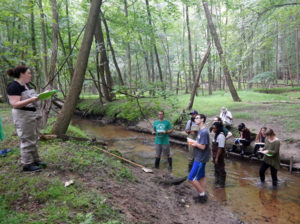 (Blackwood) – On June 16th and 17th the Stroud Water Resource Center held a Stream School at Camden County College. This partnership was arranged by the SJLWT with the NJDEP Watershed Ambassadors Program and Camden County College Biology Department. There were 17 participants including: SJLWT interns and volunteers, Rowan University students, Camden County College staff and students, Clementon Environmental Commission, Adventure Aquarium, Timber Lakes Community Association/Monroe Twp, NJDEP Watershed Ambassadors and the Environmental Protection Agency. The workshop was taught by Tara Muenz, Assistant Director of Education at Stroud Water Research Center, and Patricia Ingelido, NJDEP, Division of Water Monitoring and Standards.
(Blackwood) – On June 16th and 17th the Stroud Water Resource Center held a Stream School at Camden County College. This partnership was arranged by the SJLWT with the NJDEP Watershed Ambassadors Program and Camden County College Biology Department. There were 17 participants including: SJLWT interns and volunteers, Rowan University students, Camden County College staff and students, Clementon Environmental Commission, Adventure Aquarium, Timber Lakes Community Association/Monroe Twp, NJDEP Watershed Ambassadors and the Environmental Protection Agency. The workshop was taught by Tara Muenz, Assistant Director of Education at Stroud Water Research Center, and Patricia Ingelido, NJDEP, Division of Water Monitoring and Standards.
On Friday Toni Heater/NJDEP Watershed Ambassadors gave an overview of the Watershed Ambassador program and the opportunities it offers. Tara reviewed macro invertebrates and their life cycles, how they are identified, and different species’ tolerance for pollution, as well as stream water quality and watersheds. Patricia Ingelido reviewed NJDEP reporting forms and how to fill them out. Watershed Ambassadors had collected macro invertebrates from Cape May County and Mercer County, I collected MI’s from a local stream. Participants received hands-on experience sorting and IDing a wide range of MI’s, including species not found in this area.
In the afternoon we went to Big Timber Creek, below Blackwood Lake. I gave an overview of the history Big Timber Creek Watershed, its flora and fauna, and the CCMUA’s role in cleaning it up. I told of fishing in the creek and Blackwood Lake in the 1960’s and the changes I have observed since then.
Participants learned how to use a D net and which types of stream locations should be searched. We then spent two hours practicing netting, handling, and IDing of MI’s. We also caught two juvenile American eels. After the survey, participants learned the importance of proper decontamination of their boots, nets and other gear. The MI’s caught were taken back to the lab for further IDing and examination. Participants were able to closely examine many types of MI’s found in the area. The MI’s were then returned to the streams where they were found.
On Saturday morning we met at Camden County College. Patricia Ingelido reviewed the NJDEP Visual Stream Monitoring protocol, after which participants practiced IDing unmarked, preserved MIs. After lunch we met at Mason’s Run, at the Camden County Hidden Lake Property where I led a short botany walk at this diversity rich location. Local teacher and biologist Brian Byrnes joined us and to talk about Mason’s Run, it’s history, the native brook trout population it contains (the only native population left in South Jersey), and local efforts to have the stream protected.
Patricia Ingelido and the Watershed Ambassadors led participants through the visual stream assessment process, how to measure stream width and depth, determine stream flow and how to fill out the reporting form. Tara, Patricia and the Watershed Ambassadors then led participants through another macro invertebrate assessment of the stream. We saw many pollution-intolerant MI’s in this very clean stream, including mayflies, water snipes and case maker caddis flies. After the survey we decontaminated our nets, boots and gear.
Participants were enthusiastic and some expressed interest in working with us on future stream surveys. Special thanks to Dr. Connolly/CCC, Tara Muenz/ Stroud Water Research Center, Patricia Ingelido and Toni Heater from NJDEP for helping make this happen after we were rained out the first time. Thanks to Watershed Ambassadors Jim Hansen, Katee Meckeler, Amy Loesser and Aysia Gandy for their help. Thanks to Brian Byrnes for joining us on Saturday and talking about Mason’s Run and brook trout.
